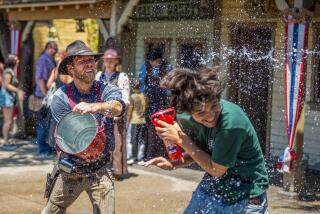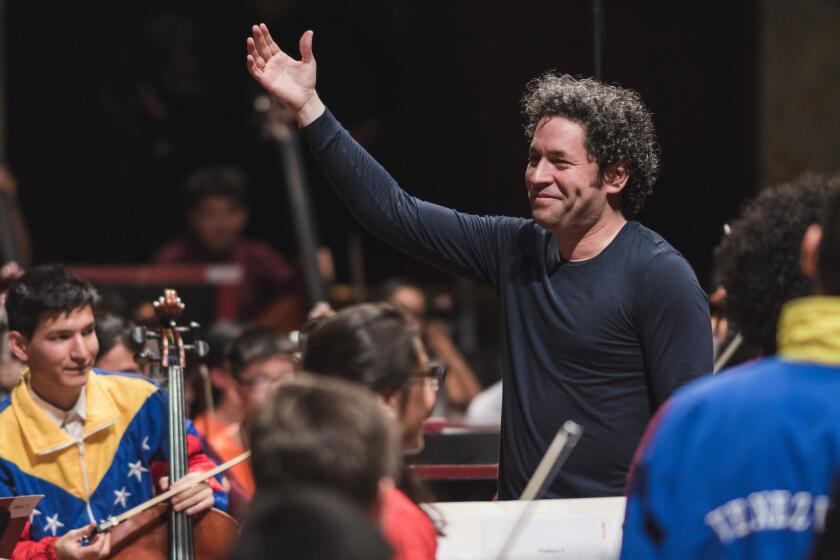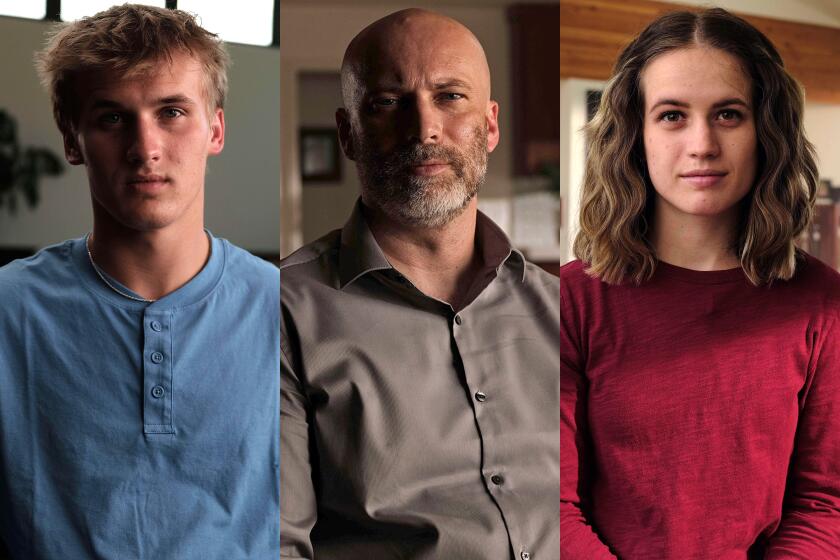Disney ride takes video game play to new level
- Share via
What do you get when you combine a shoot-’em-up video game with an amusement park ride?
Disney hopes you get a way to lure jaded gamers off the couch and to one of its theme parks.
Walt Disney Imagineering melded the interactive elements of a video game with the kind of immersive 3-D experience of an amusement park to create Toy Story Midway Mania, a ride opening today at Disney’s California Adventure park in Anaheim.
Riders don 3-D glasses, board a vehicle and travel through carnival games hosted by familiar characters from the “Toy Story” movies. They move in rapid-fire fashion past giant screens displaying classic games of skill, reinterpreted through Pixar Animation Studios’ stylized palette. There’s Buzz Lightyear’s ring toss, Woody’s Rootin’ Tootin’ Shootin’ Gallery and Bo Peep’s dart throw. The 3-D characters coax players through each game, offering tips and encouragement.
Toy Story Midway Mania is the first installment in a $1.1-billion, five-year effort to upgrade Disney’s California Adventure, which has remained in the shadow of neighboring Disneyland. Opened in 2001 under the direction of former Chief Executive Michael Eisner, the park was quickly dubbed by wags as “Eisner’s misadventure” for its poor performance. Roy Disney, Walt Disney’s nephew, blasted the company for building it “on the cheap.”
As part of the sweeping renovations, California Adventure’s entry plaza will be redesigned to evoke the 1920s, when Walt Disney arrived in California to begin his animation career. Future attractions will include Cars Land, featuring a Radiator Springs Racers ride, inspired by the Disney/Pixar blockbuster “Cars” movie.
“The strategy in all our parks, and Disney’s California Adventure is no exception, is to continue to invest and broaden the experience that we offer our guests,” said Jay Rasulo, chairman of Walt Disney Parks and Resorts.
An infusion of capital and ideas isn’t coming a moment too soon. According to entertainment and leisure consulting firm Economics Research Associates, attendance at California Adventure was 5.7 million in 2007, a drop of 4.5% from the previous year. That’s a fraction of the nearly 14.9 million people who went to Disneyland in 2007.
“California Adventure has had to reinvent itself a bit from its initial concept, which struggled,” said John Robinett, senior vice president at ERA. “This sort of ride appeals more to the broader family market, whereas the initial concept was meant to be somewhat more adult-oriented. That didn’t really perform at the level that they expected it to.”
Toy Story Midway Mania illustrates the extent to which theme park operators are employing technology to pry a generation of media-saturated kids and adults loose from their computer screens and through the turnstiles. Universal Studios has its Men in Black Alien Attack in Florida, in which guests zap space aliens as they chase them through the streets of New York. Disneyland also has its earlier “Toy Story”-inspired space ride, Buzz Lightyear Astro Blasters, in which players team up to battle the evil Emperor Zurg.
Park operators are walking a tightrope, however, in trying to develop rides that provide the kind of individualized experience that gamers covet -- in which they’re competing against each other and influencing the action -- while also appealing to non-gamers who want a more traditional, non-interactive experience.
“There are an awful lot of people who will come to an attraction and say, ‘You are responsible for my entertainment,’ ” said Bill Coan, president of Itec Entertainment, a theme park designer in Orlando, Fla. “The gamers come in and say, ‘I want to have an effect on my entertainment.’ Therein lies the balance that all theme parks are trying to deal with.”
Ben Worley, 22, is just the type of person Disney is targeting. During a preview ride this month, the game enthusiast from Riverside said he realized he was in for something novel when a life-sized depiction of Woody coaxed him to take target practice with the “spring-action shooter” mounted on the front of the tram. Worley said he popped Woody in the head with a virtual pie -- and the character reacted by shaking off the glob.
“The idea of the ride being aware is absolutely mind-blowing,” Worley said. “It’s not an experience that I typically have [at an amusement park]. Things are typically passive.”
But some analysts say that building theme park attractions with an eye to gamers may be too narrow a strategy. Gary Goddard, a former designer at Walt Disney Imagineering who now runs his own firm, said he was not convinced that theme park patrons were eager to repeat their video gaming experience. “I don’t know that there’s a trend in that,” he said.
Instead, Goddard believes, seen-it-all audiences are looking for spectacle. Attractions that employ the creative arsenal that only a theme park can marshal -- such as live-action stunts, special effects and 3-D film to make the audience believe it’s part of the action -- have broad appeal.
Toy Story Midway Mania’s designers employed super-sized versions of iconic toys -- cans of Play-Doh, interlocking chains of plastic primates from a Barrel of Monkeys and the Candyland game board -- to create the illusion that guests have been shrunk to the size of a toy. In this way they feel as though they’ve entered the room of “Toy Story” kid protagonist Andy.
Animators studied the “Toy Story” movies to capture the subtle movements and gestures that made Buzz, Woody and the other familiar characters come to life, then re-created them in 3-D for the ride. These are not linear animation sequences but a library of actions and responses that allow the characters to react with participants in real time.
“It’s like they’re alive in front of you,” said Roger Gould, theme park creative director for Pixar.
Walt Disney Imagineering borrowed the familiarity and simplicity of classic carnival games to make its interactive experience comfortable for a variety of players.
“Although we knew this was going to appeal to kids who play the Wii or the Xbox or online games, we have a family audience,” said Susan M. Bryan, a show producer for Imagineering. “I really wanted every single person who got on that ride to not only have fun but feel like they’re being successful.”
The ride’s complexity is hidden from view. Toy Story Midway Mania employs more than 150 computers communicating over multiple networks to synchronize the myriad moving parts. It keeps track of the location of every vehicle, cues the right music and lighting, and causes the on-screen characters and targets to respond every time a rider pulls the spring-action shooter.
Although Worley confessed that California Adventure initially held little interest for him, he had such a good time on the preview ride that it changed his mind. “I honestly went and told all my friends that have annual passes that this ride will be the reason you will renew,” he said.
--
--
(BEGIN TEXT OF INFOBOX)
7
Duration of ride in minutes
56
Number of interactive screens
2
Routes through the attraction
8
Number of
riders per car
23
Number
of cars
330,000
High game score this week
More to Read
The biggest entertainment stories
Get our big stories about Hollywood, film, television, music, arts, culture and more right in your inbox as soon as they publish.
You may occasionally receive promotional content from the Los Angeles Times.










